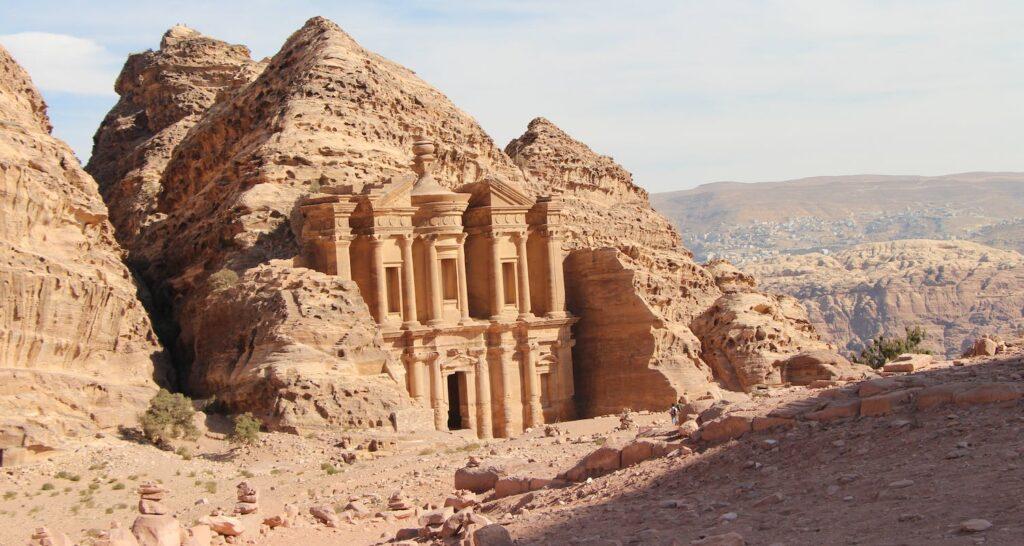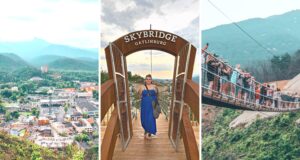The well-trodden route through Petra is taken by hordes of tourists every day. It shouldn’t be missed and takes you past the highlights of this ancient Nabataean city. But if you want something more, if you want to see things others miss, and you’ve got an adventurous spirit, there are hidden gems to discover in Petra.
This post may contain affiliate links. Please see our disclosure.

You’ll need more than an adventurous spirit, you’ll also need extra time, and physical fitness to reach some of these places. So if you plan on discovering the hidden gems of Petra I recommend that you visit for two days.
One day to see the usual highlights from the Treasury, along the Street of Facades and to the Monastery; and another day to get off the beaten path. Consider touring Petra from Israel if you want to see more than one country on one trip. Here are the top hidden gems in Petra for adventurous travelers.
The Petra Trails
- Red Trail: This is the main route through the city that is taken by all first-time visitors from the Visitor Center, through the Siq, past the Treasury, along the Street of Facades, past the Theater, the Colonnaded Street, and the Great Temple. Just off this path are the Royal Tombs and the Church which can be easily visited from this trail.
- Pink Trail: The Ad-Deir Trail stretches from the end of the Red Trail to the Monastery (Ad-Deir). The trail’s main attraction is the MOnastery but it also offers brilliant views across the city.
- Green Trail: Al Khubtha Trail bears off from the Red Trail immediately after the Theater. It takes you past the Royal Tombs and up a steep hill for Insta-worthy views of the Treasury.
- Orange Trail: The High Place of Sacrifice Trail is sort of a hidden gem because not so many tourists choose to make the difficult walk up the steep path that stretches for 3km/1.9 miles. The trail starts just before the Theater and ends near the Monastery Trail. It is a one-way route but you’ll be rewarded with spectacular views across Petra.
High Place of Sacrifice
Ascend to the High Place of Sacrifice along the Orange Trail to see an enclave of temples and altars, boasting breathtaking vistas of the valley below. Imagine the ancient Nabataeans making the trek up the stairways and paths to this site where they made their animal sacrifices. See two 7-meter-high obelisks which may represent ancient deities. The route up to the High Place of Sacrifice is one way but you can continue your hike by descending through the valley of Wadi Farasa.
Wadi Farasa
On the descent back to the main trail from the High Place of Sacrifice, venture a bit further and take a stroll along Wadi Farasa. You’ll see the Lion Fountain, the Garden Tomb, and the Tomb of the Roman Soldier. Continue to the Renaissance Tomb and the Pharaon Column.
To get even more out of Wadi Farasa continue toward the distant Jebel Haroun (Aaron’s Hill) massif. This day-long excursion unveils an entirely different facet of Petra’s landscape and culture. Enjoy undulating hills, shepherds tending to their flocks, and a notable absence of tourists. You’ll reach a hilltop tomb believed to be that of Moses’ brother Aaron, and from here there are sweeping panoramic views including a wide-angle perspective of the Monastery.
Madras Trail
If you want to feel like Indiana Jones, then hike into Petra along the Madras Trail, also known as the Indiana Jones Way. You’ll see the city from the same perspective as the Swiss explorer Burckhardt who rediscovered Petra in the 19th century. Reach the Madras Trail from the main entrance, just before the entrance to the Siq. This lesser-traveled path takes you around the southwestern side of Petra, circumventing the usual route through the city and bringing you to the High Place of Sacrifice. It doesn’t mean you’ll miss the usual sites as you can just work your way backward to the Treasury and Siq. This route is not always marked clearly and can be difficult to follow, so consider getting a guide. You’ll be rewarded with a unique overlook of the Treasury looking towards the ancient Theater.
Al Habis
Most tourists end their walk through Petra at the monastery or Qasr al-Bint but don’t stop there. Take the staircase behind Qasr al-Bint to the old museum, once housed in a rock-cut cave, and pass the tea shop to reach Jabal al-Habis. Pause along the trail for the views of the Royal Tomb, Wadi Farasa, and Wadi Thughra and continue up the steep path. You’ll reach the ruins of a Crusader fort built in about AD 1115. It was built in this strategic location overlooking the Egyptian trade route. Descend from the southern plateau on stone stairs that take you behind Qasr al-Bint. At the foot of the mountain don’t miss the unique Columbarium where niches were carved into the rock to house pigeons. The Unfinished Tomb can also be found at the base of the mount.
Little Petra
This hidden gem has unfortunately been discovered by too many tourists, but it is still worth seeing. It was once a suburb of ancient Petra and can be used as a back entrance to the archaeological park. If you follow the route through Little Petra you will arrive at the Monastery Ad Deir in the main archaeological park. But it is about 9 km from Wadi Musa and to reach the entrance to Little Petra you’ll need transport. Like the main city of Petra, Little Petra has rock-cut structures, views of beautiful mountainscapes, temples, and even a painted house, but it is on a much smaller scale than Petra. Like the main entrance, Little Petra is entered via a Siq – a narrow canyon stretching for 350 meters. It is called Siq al-Barid, or Cold Siq, as it gets a little light and can be extremely chilly.
Beidha Neolithic Village
About 800 meters from the entrance to Siq al-BArid (Little Petra) is one of the most ancient sites in the Middle East. This Neolithic village offers a glimpse into how people lived 10,000 years ago. The village is from about 8,500 BC to 5,500 BC and includes the remains of homes, and other structures. To get a sense of how the village would have looked thousands of years ago, there are full-size replicas of the Neolithic houses, as well as signage with lots of interesting information.
- Believe In Aliens? Visit These 7 Out Of This World Places - April 27, 2024
- 9 Weird Things To Do In Dublin, Ireland - April 13, 2024
- 14 Weird Things To Do In Indianapolis, Indiana - April 13, 2024




